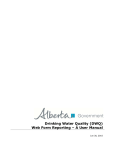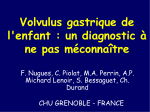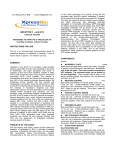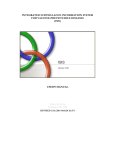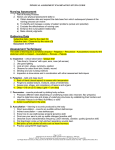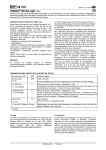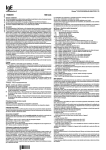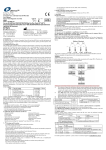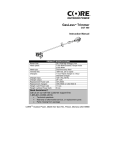Download AFP - User Manual - Canadian Paediatric Surveillance Program
Transcript
Acute Flaccid Paralysis Detailed Questionnaire USER MANUAL This user manual is intended to provide guidance on how to complete the Canadian acute flaccid paralysis (AFP) detailed questionnaire. This questionnaire can be found online at: www.cpsp.cps.ca/surveillance/study-etude/acute-flaccid-paralysis. Table of Contents Background ................................................................................................................................................... 2 Purpose and Objectives ................................................................................................................................ 2 AFP Case Definition ....................................................................................................................................... 3 Notifying Public Health ................................................................................................................................. 3 Section 1 – Demographic Information .......................................................................................................... 4 Section 2 – Relevant Medical History ........................................................................................................... 4 Section 3 –Travel and Immunization History ................................................................................................ 5 Section 4 – Clinical Features and Recent Infection History .......................................................................... 6 Section 5 – Investigations ............................................................................................................................. 7 Section 6 – Diagnosis and Outcome ............................................................................................................. 9 Section 7 – Comments ................................................................................................................................ 10 Section 8 – Reporting Physician / IMPACT Centre ...................................................................................... 10 AFP Detailed Questionnaire User Manual Page 1 of 10 Background Acute flaccid paralysis (AFP) is a potential outcome of poliovirus infection that involves the acute onset of paralysis in one or more limbs. The differential diagnosis for AFP includes a number of other conditions such as Guillain-Barré syndrome, transverse myelitis and other infections (e.g., other enteroviruses, campylobacter, etc.). The World Health Organization (WHO) has recommended that countries conduct surveillance of AFP in order to monitor for polio. Continued surveillance for poliomyelitis is essential because of the risk of wild virus importation from polio-endemic regions, a risk that remains until global polio eradication is achieved. Canada was certified polio-free in 1994 by the WHO and continues to conduct surveillance of AFP to ensure that the country’s polio-free status remains intact. Surveillance of AFP in Canada is a collaborative effort between the Canadian Paediatric Society and the Public Health Agency of Canada. It was initiated in 1991 when AFP was chosen as one of the surveillance targets for the pilot of the Canadian Immunization Program ACTive (IMPACT). In 1996, the program was enhanced when AFP was also included as a surveillance target in the newly formed Canadian Paediatric Surveillance Program (CPSP), a program collecting data from a network of paediatricians across the country. All reported AFP cases are reviewed to determine compatibility with national surveillance definitions for paralytic poliomyelitis. The information provided by participating physicians and nurse monitors in the detailed questionnaire is essential for this adjudication process. A report describing study findings is provided to all participating physicians and nurse monitors on an annual basis. Purpose and Objectives The purpose of the national AFP surveillance system is to monitor Canada’s polio-free status by ensuring a sensitive, active surveillance system and prompt, appropriate investigation of AFP cases to rule out the possibility of poliovirus infection. The objectives of the Canadian AFP surveillance system are based on three performance indicators used by the World Health Organization to determine whether AFP surveillance is of ‘certification’ standard. They are as follows: Detect at least one case of non-polio AFP per year for every 100,000 children less than 15 years of age. Collect adequate stool sample results from at least 80% of cases within 14 days of onset of paralysis. Collect data on follow-up exams at least 60 days after onset of paralysis to verify the presence of residual paralysis in at least 80% of AFP cases. AFP Detailed Questionnaire User Manual Page 2 of 10 AFP Case Definition Case definition: Acute onset of focal paralysis or weakness characterized as flaccid (reduced tone) without other obvious cause (e.g., trauma) in children less than 15 years old. Transient weakness (e.g., post-ictal weakness) should not be reported. Report all patients who: Are less than 15 years old (i.e., case has not reached their 15th birthday) Experience acute onset of focal paralysis or weakness characterized as flaccid (reduced tone) without an obvious cause (e.g., trauma) Are either admitted to hospital or treated as outpatients The case definition excludes: Patients aged 15 years and older Patients with transient weakness (e.g., post-ictal weakness) Notifying Public Health Polio: All polio cases should be IMMEDIATELY reported to your local public health unit. Acute flaccid paralysis: Please report all AFP cases to your local public health authority if this is legislatively required in your jurisdiction. Jurisdictions where AFP is reportable include Alberta, Saskatchewan, Ontario, Quebec, Newfoundland and Labrador, New Brunswick (only Guillain-Barré syndrome), Nova Scotia, Prince Edward Island, and the Northwest Territories. AFP Detailed Questionnaire User Manual Page 3 of 10 Section 1 – Demographic Information 1.1 Date of birth: Enter the patient’s date of birth using the DD/MM/YYYY convention, with two digits for day, two digits for month, and four digits for year. 1.2 Sex: Enter the sex of the patient by selecting either male or female. Select unknown if no information on the patient’s sex is available. 1.3 First three digits of postal code: Enter the first three characters of the postal code of the patient’s usual residence. This is limited to only the first three characters (the forward sortation area) to maintain privacy. For foreign visitors, enter the patient’s home country name. For individuals with no fixed address, enter the first three characters of the postal code of the reporting IMPACT centre, hospital, or medical practice. Section 2 – Relevant Medical History 2.1 Is the child immunocompromised? Indicate if the patient is currently immunocompromised in any way. If so, briefly describe the conditions causing the patient to be immunocompromised. Conditions may include: Neutropenia, acute or chronic: Include any patient with an absolute neutrophil count less than 1000. Immunosuppresed due to cancer therapy: Includes any form (chemotherapy or radiation) or stage (induction or maintenance) of chemotherapy, ongoing or completed in the previous three months. Post-bone marrow or stem cell transplantation: This should be included regardless of the time since the procedure. Post-solid organ transplantation: This should be included regardless of the time since the procedure. Inherited immune deficiency: Includes any defined, inherited defect in immunity (immune globulin deficiency, complement deficiency, T-lymphocyte defects, mixed disorders). Immunosuppresed by corticosteroids and/or other current medications: Examples include cyclosporine, azathioprine, methotrexate, etc. Drugs must be taken orally and continuously. No minimum dosage or dosing frequency required. Inhaled or topical treatment with corticosteroids should not be included. HIV/AIDS: This should be included at any stage of the infection. Spleen dysfunction or absence: Absence may be congenital (including hyposplenia or polysplenia) or post-surgical. Dysfunction is presumed to exist with sickle cell disease, thalassemia major, and other diseases. Low serum immunoglobulin levels, acquired: Depletion of immunoglobulins may occur from losses in burn wounds, nephrotic syndrome, and intestinal lymphangiectasia. Local laboratory norms can be used to define abnormally low levels. Neonatal immaturity: Include for any patient with disease onset within 28 days of birth, a period during which immune responses are blunted. This condition may also occur in older infants still suffering from the effects of prematurity, such as extended intensive care, ventilation, symptomatic bronchopulmonary dysplasia, intravenous feeding requirement, recent necrotizing enterocolitis, etc. AFP Detailed Questionnaire User Manual Page 4 of 10 2.2 Does the child have any abnormal neurological history? Indicate if the patient has had a history of any abnormal neurological events prior to the event reported here. If so, briefly describe the abnormal neurological events. These may include seizure disorders of any type (including benign febrile seizures), brain injury or malformation, spina bifida, muscular dystrophy, blindness, deafness, genetic disorders with a predominant or exclusive neurological component, and/or developmental delay (except mild variations within the range of normal, such as isolated delay in walking to 18 months). Section 3 –Travel and Immunization History 3.1 Has the child travelled to another country in the 30 days prior to illness onset ? Indicate if the patient had travelled to or resided in another country during the 30 days prior to their disease onset. If so, specify the name of the country (or countries) visited and approximately when they were travelling. If further space is required, please use Section 7 (Comments). 3.2 Has a close contact travelled to another country in the 90 days prior to illness onset? Indicate if any of the patient’s household members or close contacts have travelled to or resided in another country during the 90 days prior to their disease onset. If so, specify the name of the country (or countries) visited and approximately when they were travelling. If further space is required, please use Section 7 (Comments). 3.3 Did the child receive any vaccines in the 6 weeks prior to paralysis/weakness onset? Indicate if any vaccines were administered to the patient (including any poliovirus-containing vaccines) in the 6 weeks (or 42 days) prior to paralysis or weakness onset. 3.4 Record below all vaccines the child has received in the 6 weeks (42 days) prior to paralysis/weakness onset: Enter the following information for each vaccine administered to the patient (including any poliovirus-containing vaccines) in the 42 days prior to paralysis or weakness onset: Vaccine name: Enter the generic name of the vaccine administered (e.g., DTaP-IPV-Hib). Dose number in series: Enter how many doses that the patient has received in the series for that vaccine (e.g., 2nd). Date of vaccination: Enter the date that the vaccine was administered to the patient using the DD/MM/YYYY convention (with two digits for day, two digits for month, and four digits for year). 3.5 Record below all polio immunizations ever received by this child: Enter the following information for each poliovirus-containing vaccine received by the patient in his/her life. Vaccine: Indicate if the vaccine received was inactivated polio vaccine (IPV) or oral polio vaccine (OPV). Dose number in series: Enter how many doses that the patient has received in the series for that vaccine (e.g., 2nd). Date of vaccination: Enter the date that the polio vaccine was administered to the patient using the DD/MM/YYYY convention (with two digits for day, two digits for month, and four digits for year). AFP Detailed Questionnaire User Manual Page 5 of 10 Note: Oral polio vaccine (OPV) is still used extensively outside of Canada. Please ensure that the correct vaccine administered is documented. 3.6 Are the child’s immunizations up-to-date? Indicate if the patient is considered to be up-to-date with their immunizations. This variable was included for cases for which no information on the patient’s immunization history is available except that they are up-to-date with their immunizations. 3.7 Has any household member or close contact received OPV within 90 days prior to onset of the child’s illness? Indicate if any of the patient’s close contacts received the oral polio vaccine (OPV) in the 90 days prior to the patient’s disease onset. Section 4 – Clinical Features and Recent Infection History 4.1 Date of paralysis/weakness onset: Enter the date when the patient began to experience paralysis or weakness using the DD/MM/YYYY convention (with two digits for day, two digits for month, and four digits for year). 4.2 Date paralysis/weakness reached full extent or maximal weakness: Enter the date when the patient experienced maximal paralysis or weakness (i.e., the paralysis/weakness peaked in severity), using the DD/MM/YYYY convention (with two digits for day, two digits for month, and four digits for year). 4.3 Was fever present at paralysis/weakness onset? Indicate if the patient experienced fever when paralysis or weakness first began. 4.4 Grade maximal weakness in affected limbs using the numeric codes: For each limb (right leg, left leg, right arm, and left arm), indicate the maximum level of weakness experienced by the patient with the appropriate code: 1 = The patient is unable to move the limb at all (total paralysis). 2 = The patient is only able to make minute movements or flickers with that limb. 3 = Although the patient is able to move the limb, they cannot move it against gravity. 4 = Although the limb’s active strength is reduced, the patient is still able to move it against gravity. 777 = Not applicable; the limb is not affected or the patient does not have that limb. 999 = Unknown, the weakness occurring in that limb is unknown. Use the comments section at the end of the detailed questionnaire (Section 7) to explain if the information available in the patient’s chart is insufficient to grade the weakness or the information does not have enough precision to fit into the listed categories. 4.5 Were respiratory muscles affected by paralysis/weakness? Indicate if the patient’s respiratory muscles have been affected by paralysis or weakness. These include the diaphragm, the external intercostal muscles, the accessory muscles of inspiration (scalene muscles, sternomastoids, AFP Detailed Questionnaire User Manual Page 6 of 10 alae nasi), the muscles in the abdominal wall (rectus abdominus, internal and external obliques, and transversus abdominus), and the internal intercostal muscles. 4.6 Were cranial nerves affected by paralysis/weakness? Indicate if the patient’s cranial nerves have been affected by paralysis or weakness. If so, indicate which nerves have been affected. 4.7 Were there symptoms of a current or recent (≤6 weeks before onset) infection? Indicate if the patient had symptoms of a current or recent infection. An infection is considered to be recent if it occurred within 6 weeks (or 42 days) of symptoms onset. If there were symptoms of a current or recent infection, complete questions 4.7.1 and 4.7.2. If not, go on to question 5.1. 4.7.1 If yes, describe the type of infection. If the patient had symptoms of a current or recent infection, indicate whether it was a respiratory tract infection, a gastrointestinal infection, or another type of infection. If “Other” is selected, please specify the type of infection. 4.7.2 If yes, was there a positive laboratory test (e.g., microbiological or serological) confirming an infection? If the patient had symptoms of a current or recent infection, indicate whether there was a positive laboratory test confirming an infection. The test can include microbiological or serological tests. If “Yes” is selected, please specify the organism or type of infection identified in the space provided. Section 5 – Investigations 5.1 Please indicate which of the following procedures were conducted and describe the results in the space provided: For each of the diagnostic procedures listed, indicate if the procedure was conducted (yes, no, or unknown) during the patient’s hospitalization. If so, indicate what body part was imaged (e.g., brain, spinal cord) and if the results were considered to be abnormal (Abn), normal (N), or unknown (Unk). Describe the results in the space provided. If further space is required, use the comments section at the end of the detailed questionnaire (Section 7) or attach a copy of the results to the completed questionnaire (with any personal identifiers removed). EMG/NCS: Electromyogram or nerve conduction studies MRI: Magnetic resonance imaging CT: Computed tomography scan 5.2 Please indicate which of the following laboratory tests were conducted and provide details in the space provided: For each of the laboratory tests listed, indicate if the test was conducted (yes, no, or unknown) during the patient’s hospitalization. If the laboratory test was conducted, provide the following information for each test: Date: Indicate the date that the test was conducted using the DD/MM/YYYY convention (with two digits for day, two digits for month, and four digits for year). Result: Indicate if the test results were considered to be positive (Pos), negative (Neg), or were unknown (Unk). Organism: Indicate what organisms were identified in each positive culture. Laboratory: Enter the name of the laboratory where the test was performed. Also include its city and province/territory. If “Other (viral testing)” is selected, provide the name of the test. AFP Detailed Questionnaire User Manual Page 7 of 10 Note: Every case of AFP occurring in Canada should have one stool sample obtained within 14 days of paralysis onset. The sample should be submitted to the National Microbiology Laboratory (NML) with the completed requisition form, which can be found at the end of this user guide or: http://open.cnphi-rcrsp.ca/gts/faces/public/laboratory.xhtml?labId=1012&lang=en Purpose: Collection of adequate stool sample results for at least 80% of AFP cases within 14 days of paralysis onset and processing of the samples in a World Health Organization (WHO)-accredited laboratory is an important WHO performance target that the national AFP Surveillance System strives to meet. The NML is the only WHO-accredited laboratory in Canada and is able to not only perform appropriate culture testing, but also molecular testing to genoptype any enterovirus from stool, CSF, or respiratory specimens as part of testing to rule out wild-type, vaccine-strain, or vaccine-derived poliovirus. This is done with a turnaround time that can benefit patient care. Confidentiality: It is not necessary to obtain patient consent since the sample is being sent to NML for normal diagnostic purposes. All information collected on the laboratory requisition form will remain with the NML and not be shared with the Canadian Paediatric Surveillance Program. Procedure: A stool sample should be obtained within 14 days of paralysis onset. All that is needed for stool sampling is a suitable container (such as one would use for a urine specimen). This can be stored safely in a standard freezer until it can be shipped to the NML; polioviruses or other enteroviruses, if present, are viable for several months when stored under these conditions. Although the stool sample can also be kept in a refrigerator, freezing is preferred. Please contact the NML when you are ready to ship the specimen: Enteroviruses and Enteric Viruses National Microbiology Laboratory 1015 Arlington Street, Winnipeg, MB R3E 3R2 Telephone: 204-789-2022 / 204-789-2082 Email: [email protected] The NML will provide you with a Fed-Ex shipping account number so that shipping will be at NML’s expense. The sample does not have to be shipped frozen. All you need to do is call Fed-Ex and arrange for the package to be picked up. If preferred, NML can also send a special self-addressed package (including containers) to your office or laboratory by Fed-Ex. Packages only take 24 to 48 hours to arrive. More information regarding the protocol for investigating acute flaccid paralysis cases can be found on the CPSP webpage: http://www.cpsp.cps.ca/surveillance/study-etude/acuteflaccid-paralysis. AFP Detailed Questionnaire User Manual Page 8 of 10 5.3 a) Please indicate if a CSF examination was conducted and provide details in the space provided: Indicate if the cerebrospinal fluid was examined and if viral testing was done on a sample of it (yes, no, or unknown) during the patient’s hospitalization. If either was conducted, provide the following information: Date: Indicate the date that the test was conducted using the DD/MM/YYYY convention (with two digits for day, two digits for month, and four digits for year). Result: Indicate if the test results were considered to be positive (Pos), negative (Neg), or were unknown (Unk). Organism: Indicate what organisms were identified in each positive test. Laboratory: Enter the name of the laboratory where the test was performed. Also include its city and province/territory. b) If CSF examination results were abnormal, indicate which parameters were abnormal and provide the exact values: If a CSF examination was conducted and the results were abnormal, provide the values and its units of measurement for the parameters with abnormal results. For patients with multiple samples taken, report on the most abnormal results. Section 6 – Diagnosis and Outcome 6.1 Was the child hospitalized? Indicate if the patient was hospitalized due to this health event. If the answer is “Yes”, indicate the duration of hospitalization in days, weeks, or months. 6.2 Indicate the outcome, using the appropriate numeric code provided: Enter the appropriate code to describe the outcome of this episode of paralysis/weakness, both at the time of the initial report (6.2.1), and at least 60 days after the onset of paralysis/weakness (6.2.2). For 6.2.1, indicate the date when the patient’s outcome was initially assessed using the DD/MM/YYYY convention (with two digits for day, two digits for month, and four digits for year). 1 = The patient has fully recovered. 2 = Although the patient has partially recovered, they continue to experience residual paralysis or weakness. 3 = The patient’s outcome is still pending. The patient has not yet recovered and/or the condition has progressed. 4 = The patient has died due to the paralysis/weakness. 777 = Not applicable: It is not yet 60 days post paralysis onset. 999 = The outcome of the patient is unknown. Note: Collection of data on follow-up exams at least 60 days after the onset of paralysis to verify the presence of residual paralysis in at least 80% of AFP cases is an important World Health Organization performance target that the National AFP Surveillance System strives to meet. Every case should be followed-up at least 60 days after paralysis onset to verify the presence of residual paralysis. Ensure that this information is returned to the CPSP. AFP Detailed Questionnaire User Manual Page 9 of 10 6.3 Please indicate the final diagnosis: Indicate what the final diagnosis of the patient was. If “Other” is selected, please specify the final diagnosis in the space provided. Guillain-Barré syndrome Guillain-Barré syndrome (Miller-Fisher variant) Transverse myelitis Note: All cases of poliomyelitis should be Acute disseminated encephalomyelitis (ADEM) IMMEDIATELY reported Acute poliomyelitis to your local public Vaccine-associated poliomyelitis health unit. Other 6.4 Please indicate the level of certainty associated with the final diagnosis: Indicate if the patient is considered a probable or a definite case of the final diagnosis reported above (question 6.3). This will assist with adjudicating the case. 6.5 Is there any suspicion at all that this might be related to infection with poliovirus: Indicate if there is any suspicion that the patient’s illness is associated with a poliovirus infection. If yes, describe why this suspicion exists. Section 7 – Comments 7.1 Please provide any comments you wish to include that may help with case classification: Include any additional information that may assist in either confirming or ruling out the patient as a case of poliomyelitis. Section 8 – Reporting Physician / IMPACT Centre 8.1 Date completed: Enter the date when this detailed questionnaire was completed using the DD/MM/YYYY convention (with two digits for day, two digits for month, and four digits for year). 8.2 IMPACT centre: If you are completing the questionnaire on behalf of an IMPACT centre, check yes. Otherwise, check no. Please note that the following information will remain with the Canadian Paediatric Surveillance Program and will not be shared with the Public Health Agency of Canada. First name: Enter your first name (i.e., given name). Surname: Enter your surname (i.e., last name). Address: Enter the street address and room number of your place of work. City: Enter the city of your place of work. Province: Enter the province of your place of work. Postal code: Enter the postal code of your place of work. Telephone number: Enter the telephone number that you can be reached at regarding this patient. Fax number: Enter the fax number that you can be reached at regarding this patient. E-mail: Enter the e-mail address that you can be reached at regarding this patient. AFP Detailed Questionnaire User Manual Page 10 of 10 Enteroviruses and Enteric Viruses National Microbiology Laboratory 1015 Arlington Street, Winnipeg, MB R3E 3R2 Telephone: (204) 789-2022 / (204) 789-2082 Email: [email protected] REQUISITION FOR ENTEROVIRUSES AND ENTERIC VIRUSES SENDER INFORMATION PASSAGE HISTORY OF ISOLATE: NAME: ORIGINAL SPECIMEN (EG. STOOL): CELL LINE USED (EG. MONKEY KIDNEY): ADDRESS: PASSAGE NUMBER OF ISOLATE: CITY: OTHER TESTING RESULTS (EG. IFA; NEUTRALIZATION): PROVINCE: POSTAL CODE: SUSPECTED VIRUS TELEPHONE: FAX: ENTEROVIRUS PARECHOVIRUS POLIOVIRUS NOROVIRUS PATIENT INFORMATION OTHER (SPECIFY): NAME-CODE: TEST REQUESTED DATE OF BIRTH (YYYY-MM-DD): ENTEROVIRUS MOLECULAR DETECTION / TYPING SEX M F CITY: PROVINCE: POLIOVIRUS DETECTION AND INTRATYPIC DIFFERENTIATION NOROVIRUS MOLECULAR DETECTION OTHER INFORMATION: SPECIMEN INFORMATION FOR PRIMARY SPECIMENS: SPECIMEN REF #: CLINICAL HISTORY PARALYSIS VOMITING ASEPTIC MENINGITIS HAND-FOOT-MOUTH DISEASE DIARRHEA PERICARDITIS EPIDEMIC PLEURODYNIA MYOCARDITIS HERPANGINA ACUTE HEMORRHAGIC CONJUNCTIVITIS OTHER (SPECIFY): EXPOSURE TO POLIO VACCINE: DATE TAKEN (YYYY-MM-DD): STOOL RECIPIENT CONTACT TRAVEL HISTORY OTHER (SPECIFY): LOCATION: FOR VIRAL ISOLATES: DATE (YYYY-MM-DD): SPECIMEN REF #: LOCATION: DATE TAKEN (YYYY-MM-DD): DATE (YYYY-MM-DD): The Client and NML agree that this requisition acts as an agreement for the NML to provide testing, as described in the Guide to Services, for the above requested tests. July 2013











